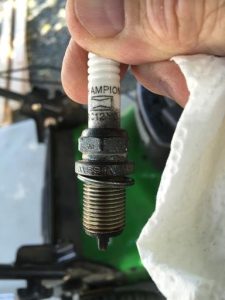
Spark plugs are one of the important parts of an engine that is responsible for creating the spark that ignites the air-fuel mixture in the engine cylinders. This controlled explosion is what powers the vehicle and propels it forward.
When spark plugs are in good condition, they provide a consistent and powerful spark, ensuring perfect combustion, but when they are bad, they will fail to provide a strong and consistent spark, leading to incomplete combustion and various issues. So, when the plugs go bad, how long can you drive with a bad spark plug?
You can drive for a short period with bad spark plugs depending on how many plugs are bad but continuing to drive with bad spark plugs can cause damage to the catalytic converter, oxygen sensors, and other engine components.
Can You Drive with Bad Spark Plugs?
Yes, “you can technically drive with bad spark plugs for a short period, but it is strongly advised against”. Driving with bad spark plugs can lead to poor engine performance, reduced fuel efficiency, and damage to other engine components.
How Long Can You Drive with Bad Spark Plugs?

The duration you can drive with bad spark plugs varies based on the severity of the issue. In mild cases, you might drive for a limited time with reduced performance. However, severe spark plug issues can lead to significant problems, making it a bad idea to drive in such conditions.
It is not recommended to drive for an extended period with bad spark plugs, rather, the spoilt plugs should be replaced as soon as possible.
If the spark plugs show early signs of wear, such as light fouling or minor erosion, the vehicle might still function, albeit with reduced performance, which means, you can still drive the car, at least to a mechanic shop or where the plugs will be replaced.
However, vehicles with severely damaged or completely failed spark plugs are at a higher risk of experiencing issues such as engine misfires, increased fuel consumption, and damage to the catalytic converter, therefore, driving the car in such condition is not advisable.
When your spark plug goes bad, you should only be able to drive the car to where the spark plugs will be replaced or at least drive home. You should avoid driving the car for a long time.
Also, the type of driving conditions you place the car will influence the duration you can drive with bad spark plugs. Stop-and-go traffic, frequent idling, and heavy acceleration can put more strain on the engine, making the negative effects of faulty spark plugs to be prominent.
What Happens If You Keep Driving with Bad Spark Plugs?
Continuing to drive with bad spark plugs can have several negative consequences for your vehicle, such as:
1. Reduced Engine Performance
Bad spark plugs can lead to incomplete combustion, resulting in reduced engine performance. You may experience issues such as rough idling, poor acceleration, and an overall decrease in power.
Your car will not be as smooth as it used to be and may not answer you as fast as it is used to when you put your foot on the accelerator pedal. This can be frustrating, especially for those who drive a V6/V8. You will notice your car not responding as it used to.
2. Decreased Fuel Efficiency
Inefficient combustion due to bad spark plugs can lead to increased fuel consumption. This means your vehicle will cover fewer miles per gallon of fuel than it used to do, ultimately reducing fuel efficiency. You will find yourself frequenting the gas station.
3. Engine Misfires
Faulty spark plugs are a common cause of engine misfires. These misfires can lead to a jerking or sputtering sensation while driving, compromising the smooth operation of the engine.
4. Catalytic Converter Damage
Unburned fuel reaching the catalytic converter can cause it to overheat and fail. Replacing a catalytic converter is an expensive repair that can be triggered by driving with bad spark plugs for an extended period.
5. Oxygen Sensor Issues
Bad spark plugs can result in a rich fuel mixture, damaging oxygen sensors. These sensors are important for monitoring and adjusting the air-fuel ratio, and their impairment can lead to increased emissions and poor gas mileage.
6. Engine Damage
Prolonged driving with bad spark plugs can contribute to engine damage. Persistent engine misfires may lead to increased wear on engine components such as piston rings and cylinders, necessitating costly repairs.
7. Environmental Impact
Incomplete combustion caused by bad spark plugs contributes to higher levels of harmful emissions. This not only impacts your vehicle’s environmental footprint but may also lead to a failed emissions test in regions where testing is mandatory.
How Do You Know if Your Spark Plugs are Bad While Driving?
Identifying bad spark plugs while driving involves paying attention to specific symptoms and changes in your vehicle’s performance.
Here are common signs that your spark plugs may be in poor condition:
- Rough Idling: If your engine idles unevenly, producing vibrations and a shaky sensation, it could be a sign of bad spark plugs causing irregular combustion.
- Poor Acceleration: Reduced power and sluggish acceleration may indicate inefficient combustion due to faulty spark plugs.
- Engine Misfires: Sudden jerks or sputtering during acceleration are common signs of engine misfires, often caused by bad spark plugs failing to ignite the air-fuel mixture properly.
- Increased Fuel Consumption: If you notice a significant drop in fuel efficiency and an increase in fuel consumption, it could be attributed to incomplete combustion caused by bad spark plugs.
- Difficulty Starting the Engine: Difficulty starting the engine or prolonged cranking may indicate that the spark plugs are not generating a strong enough spark to initiate combustion.
- Reduced Power and Performance: A general decline in engine performance, such as a lack of power or responsiveness, may suggest that the spark plugs are not functioning perfectly.
- Engine Warning Light: A flashing or steady check engine light on your dashboard can be triggered by various issues, including problems with the spark plugs. It’s advisable to have the vehicle’s onboard diagnostics system checked for error codes.
- Unusual Engine Sounds: Hissing, popping, or backfiring sounds from the engine may indicate irregular combustion caused by bad spark plugs.
If you observe one or more of these symptoms while driving, it’s recommended to address the issue as soon as possible to avoid problems. Ignoring problems with spark plugs can lead to more severe engine damage and increased repair costs over time.
Conclusion
Driving with bad spark plugs may seem like a minor issue at first, but the repercussions can be significant and expensive. How long to drive with bad spark plugs depends on various factors, including the severity of the issue and the driving conditions.
In mild cases, where the spark plugs are just beginning to wear out, a vehicle might continue to run for a limited time without experiencing severe consequences. However, in cases of severe spark plug damage or multiple faulty plugs, the risks increase exponentially and the vehicle should not be driven.
As a good car owner, you should prioritize regular maintenance and address spark plug issues as soon as possible to ensure the longevity and performance of your vehicle.









